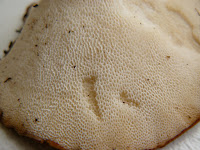This being my first blo

g about mushrooms, I'll try to explain why I am doing this and why I decided to start it.
It all starts with my wife suggesting that I should get myself a hobby. It's been many, many years since I practiced any sport regularly or did any sort of activity (apart from working and reading) consistently. My wife's primary idea was to get me out of home and do something healthy (a.k.a enjoy life). Being some sort of nerd, of course, I chose something that had some science involved. Strangely, I don't know exactly why I chose mushrooms, but I ended finding the
Mycological Association of Washington website and decided to join. Since then, I have gone to a few forays, which I enjoyed greatly, and have started to collect any mushrooms I find around my building when I go out with my wife and daughter for our daily walks.
That said, my primary objective here is to try to log my mushroom encounters and see if I can help/get helped with mushroom identification. As a cautionary note I should mention that I have just started picking mushrooms and that my first
morel season was this year. Although I am interested in edible mushrooms (as most people are), I am also interested in just learning more about all fungi. Also, being a scientist, I have a few advantages over other people in regards to mushroom identification since I can sequence certain genes to fingerprint them (although in my experience, this does not necessarily provides a definitive answer). So...let's start.
First Mushroom log
Date: 05/08/2010
Location: Rockville, MD
Measurements
Stipe length: 7.0 cm
Stipe diameter at apex: 1.7 cm
Stipe diameter at middle: 2.0 cm
Stipe diameter at base: 2.7 cm
Pileus diameter: 4.0 cm
Pileus heigth: 2.7 cm
Description
Pileus - Cream colored, convex, orbicular (ovoid), bicolorous, margin entire, surface dull, dry, covered with scales/warts which are slightly raised but not pointed, smell is not distinctive, there is no latex, lamella (gills) seem adnexed, crowded, narrow, smooth. The pileus surface bruises orange/red.
Stipe - Central, inserted, clavate, rugose at the base but not at middle or apex, white colored at middle and apex but brown at base, solid, bruises yellow at top (only), consistency is cartilaginous (breaks with firm split), does not have veil, volva or anulus (stature pluteotoid).
Spore print - Did not obtain it.
Habitat
Solitary and growing on grass.
Impression
Because it was found on grass, it has gills, no volva or universal veil remnants, it has a clavate stipe that bruises orange/red, to me it suggests that it could be a Leucoagaricus americanus, but because I did not find an annulus (ring) I am not 100% sure about it. The fact that I did not manage to obtain a spore print also does not help. I will probably have to resort to sequencing the ITS region or asking someone more experienced to confirm this. If this isthe case, it would be an edible, but given that I am not sure about this, I wouldn't suggest anyone trying to eat similar mushrooms (actually I don't suggest anyone using my blog to identify mushrooms since this is just a personal log).
Further Impressions
After submitting my photos to
Mushroomobserver.com I got some feedback from other fellow amateur mycologists pointing out that it looks like there are remnants of the universal veil (ring) on the pileus which I did not spot and that this mushrooms looks like an Amanita (unidentified species). I am still open to more feedback and will post the ITS1 sequencing results as soon as I get it.
Final Results of ITS sequencing
After sequencing the intergenic spacer region 1 (ITS1) and querying the results against the nr database using NCBI Blastn I got 100% of similarity with
Amanita muscaria. Therefore, the fellow mycologists from Mushroom Observer were right. Be advised that this is a poisonous mushroom that contains hallucinogenic compounds and therefore it should not be eaten.
For those with some molecular biology background
The sequence obtained was: gccagggctgcctacaagcagtgcacaagtggagagaatgaagaaacaagcaagagagacaacgg
The best match for the ITS1 sequence is available
here.
 Date: 05/30/2010
Date: 05/30/2010
 Impressions
Impressions 






























